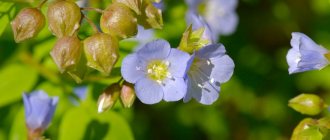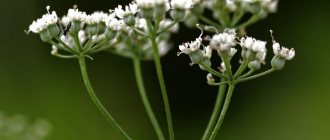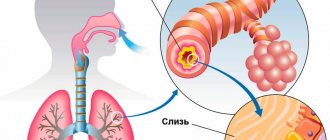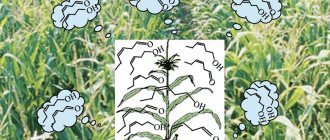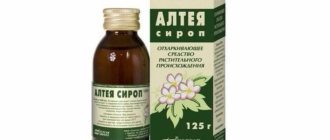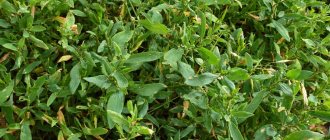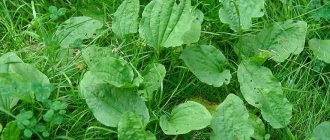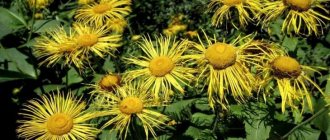This plant prefers hilly areas or wastelands, and grows especially readily on cliffs above rivers, where there is a lot of water. The leaves or flowers of coltsfoot are mainly used as medicine; they are often used as a collection in combination with other plants. For example, to combat cough, coltsfoot is combined with plantain or raspberries.
This plant got its amazing name because of its very specific temperature. Its leaves are bright green on one side and covered with a large amount of white fibers underneath. If you touch the green side of a leaf, you will feel that it is cool, regardless of the temperature around you. At the same time, the underside with fibers is very warm, and it is because of this that the plant received its unusual name.
Introduction
The choice of recipes for various coltsfoot remedies is quite large. Typically, they are used as a side therapy for colds, however, their use is not limited to this. Among different peoples living in the habitat of this species, its use could sometimes differ significantly.
Coltsfoot during flowering
In addition to its medicinal properties, coltsfoot is one of the most popular honey plants . The honey obtained from it has good taste characteristics. Just like a honey plant, coltsfoot has significant advantages.
Firstly, it produces an acceptable yield of both nectar and pollen, and secondly, due to its unpretentiousness, it can occupy large areas, that is, ensure mass collection.
Chemical composition
The medicinal properties of leaves (herbs) of coltsfoot are due to the content of the following substances in their composition: glycoside tussilarin, inulin, sitosterol, gallic, malic, tartaric and ascorbic acids, saponins, tannins and mucous substances, essential oil.
In addition, they contain the following macro- and microelements: potassium (37.70 mg/g), calcium (10.90 mg/g), iron (0.20 mg/g), bromine (107.10 μg/g ), boron (40.0 µg/g), selenium (25.00 µg/g), nickel (21.00 µg/g), silver (8.00 µg/g), copper (0.78 µg/g ), zinc (0.60 µg/g), molybdenum (0.40 µg/g), polonium (0.24 µg/g), cobalt (0.27 µg/g), etc.
Coltsfoot flowers contain: triterpenes (faradiol and arnidiol), tetraterpene taraxanthin, stigmasterol and sitosterol, carbohydrate heptacosane, tannins. Routine is also an important element.
Biological description
From a botany point of view, coltsfoot is a perennial herbaceous shrub , which is a monotypic representative of the Astrov family. This means that this species is unique in the entire family. Indeed, the structure of the plant is such that it is unlike any other.
The flowering part of the coltsfoot has a large number of small yellow flowers collected in inflorescences-baskets. A peculiarity of the plant is that its flowering occurs in early spring, and it occurs before the leaves appear.
Coltsfoot leaves on both sides
But the unique properties of this herb do not end there. Its leaves have completely different structures, which even leads to the appearance of different microclimate conditions in different parts of the leaf. The underside of the coltsfoot leaf is covered with many small hairs.
This leads to the fact that the evaporation of liquid from the lower surface of the sheet occurs very slowly, one might say, does not occur at all. At the same time, as with a smooth upper surface, especially one exposed to sunlight, evaporation occurs at a much faster rate.
Evaporating moisture causes significant cooling of the upper part of the sheet, while the lower part remains relatively warm. Sometimes the temperature gradient between the upper and lower parts of the coltsfoot leaf can reach 3°C. The lower side, which is warmer, is popularly called “mother”, and the upper, colder side is called “stepmother”.
Flowers along with the leaves that have already appeared
However, this plant also has other names. Among them you can find the following:
- one-sided
- camouflage grass
- double leaf
Moreover, sometimes coltsfoot under these names will be found in completely official sources. Translated from Latin, the official name of coltsfoot means “herb that expels coughs.”
The plant is very widespread in Eurasia. From the shores of the Atlantic Ocean to Western Siberia, it can be found at any latitude - from the Mediterranean Sea to Murmansk. However, the range of the coltsfoot, although it has a fairly large area, is not continuous.
For example, in Ukraine it is not found throughout the Dnieper Lowland, although it is found in almost the entire rest of the territory. A similar picture is observed in Scandinavia, and in Eastern Europe, and in the Middle Zone, and in the Urals. Scientists cannot yet provide an explanation for such a “spotted habitat” of a monotypic plant.
In addition, coltsfoot has a certain selectivity to soil types. For example, it is almost always found in areas where there is no turf or turf soil.
For coltsfoot there is nothing better than the various slopes of ravines or steep river banks. There are frequent cases of the plant appearing in places of intense human activity - wastelands, landfills, agricultural lands, even landfills and abandoned industries.
Wild field of coltsfoot
The plant's dislike for turf soil implies that clay soils are more preferable for the plant. And this is so: coltsfoot grows best on clay soils.
However, if the seeds of a plant find themselves in more or less favorable conditions, even on “inconvenient” sandy soils, it will be able to grow to a huge colony due to its unpretentiousness.
The plant blooms in mid-April, and after about a month its first leaves appear. The plant has a very powerful root system. The root of the plant is long and branched. The top of the root is dotted with many buds. In spring, two types of shoots are formed from them. First - shoots of peduncles, later - shoots of leaves.
Generative stems of a plant
Moreover, this does not mean that the flowers are devoid of leaves at all. Flowering or generative shoots are covered with small ovoid leaves along their entire length. They are brown in color and sometimes look very scale-like.
The coltsfoot flower is very complex in structure and consists of many small flowers of the female and bisexual types, collected in two rings relative to the center. In total, the inflorescence can contain several hundred small flowers.
Flower close up
The fruits of coltsfoot are achenes with parachutes, that is, they are very similar to the fruits of an ordinary dandelion . After the fruits are ripe, the generative shoots die off, they dry out, and around this time the seeds are dropped from the dried peduncle.
Fruits of the plant
The medicinal use of the plant is due to the set of chemical components that make up the leaves . The leaves of the plant can be up to 20 cm in diameter. They have long, hard petioles and serrated edges. Usually the number of leaves and flowers on a bush is approximately the same.
Plant leaf ready for harvest
The leaves are collected in the spring, when the concentration of essential medicinal substances in the plant is maximum . Typically, this occurs when the veins on the leaf become reddish-brown.
The use of Tsar Potion in cosmetology
Cosmetologists use the plant extract to prepare masks, creams, and rinses.
- Cream for sensitive skin. Mix a large spoonful of lanolin and half a cup of oil (olive or corn) with a tablespoon of freshly squeezed plantain juice. Beat until creamy.
- Face masks. For oily skin, an anti-inflammatory mask is prepared from two tablespoons of dry raw materials, steamed with boiling water. If you add fresh sour cream, you can use a mask to prevent wrinkles. For dry skin, the same amount of raw material is steamed with milk. For normal skin, half a glass of fresh stems should be turned into a paste and diluted with kefir (half a glass). When the mask has infused, it is applied to cleansed skin for 15 minutes. Wash off with water without soap.
- Rinse aid. To strengthen hair, prepare a decoction of camouflage grass and burdock (in equal parts). The mixture is brewed and steamed for 20 minutes. Rinse with warm infusion.
- Nail product. Brittle nails can be strengthened with a composition of lemon juice, coltsfoot leaves and an oil solution of vitamin A.
- Cigar for toothache. They are prepared from crushed dry leaves. The smoke from the cigarette is held in the mouth.
Salt substitute.
Leaves burned to ashes are used in cooking instead of table salt (if the diet requires appropriate restrictions). Humanity has been collecting medicinal herbs longer than farming. Before the development of the pharmaceutical industry, medicinal plants were the main source for the manufacture of medicines. But even today doctors recognize that natural remedies are more beneficial for humans than synthetic analogues.
With all the advantages of coltsfoot, proven over centuries, it can only be used as an auxiliary means to facilitate the patient’s quality of life after full treatment.
Growing a plant
Despite the fact that leaves for medical purposes are mostly collected in the wild, sometimes there are enthusiasts who grow coltsfoot in private.
Beekeepers also often grow this plant, since coltsfoot not only produces high-quality honey, but is also one of the earliest flowering honey plants. Traditionally, abandoned areas or vacant lots are used for these purposes, since the plant is quite unpretentious.
The plant can be propagated equally well by both seed and vegetative methods . Particularly popular is dividing the rhizome.
Due to the absence of any particular negative impact on the soil, as well as due to its good adaptability to almost any conditions, coltsfoot can grow for decades in the same place in the garden without replanting.
In this case, it may even be necessary to slightly limit the growth rate of the plant, since it reproduces extremely well and quickly covers large areas.
Bee on coltsfoot flowers
The plant feels best in partial shade, but can also grow in full sun. But the shadow doesn't really suit him.
It is believed that this plant does well without care , so no one has dealt with the issues of its cultivation, and, as a result, selection. Everyone is happy with its current state. However, the reaction of this herb to fertilizers is quite demonstrative, which makes it possible to achieve a high rate of reproduction in the first 1-2 years of cultivation.
Preference is given to organic fertilizers, which are recommended to be applied once a year at the end of autumn to the location of the plants. These can be: compost, humus or bird droppings diluted with water in a concentration of 1 to 20.
It is necessary to water the plant only in extremely hot weather , making sure that moisture does not get on the outer part of the leaves. Also, the plant does not need to loosen, hill up or mulch the soil. The existing opinion that the plant can only exist near open sources of water does not stand up to criticism - even bindweed or mallow will envy the drought resistance of coltsfoot.
Coltsfoot is often used as early flowering perennials for flower beds. And the high unpretentiousness of the plant allows them to be used in rock gardens and rockeries.
Plant in "deciduous phase" on rocky soil
Propagation by vegetative method is very simple - the daughter root is separated from the mother root in mid-spring and transplanted to a new location. Already at the end of the next season, a large colony of plants will form at the site of its planting, consisting of about a couple of dozen flowers and 2-3 daughter roots of the next generation.
In addition, do not be surprised if plants that look like coltsfoot, but are somewhat smaller, begin to hatch in all corners of the garden. This is the result of the plant self-seeding.
Small seedlings mature for about three years before they begin to bloom. At the beginning, they will form a powerful root system and a sufficient number of generative and vegetative buds will appear.
Scalpel against "weed"
Researchers from the University of Chicago once published recommendations for doctors and patients about which herbs may be dangerous for those who go under the surgeon’s knife (see table). The fact is that “gifts of nature” can behave completely unpredictably during anesthesia and immediately after surgery. The recommendations were published in the most influential medical publication in the United States, the Journal of the American Medical Association. Doctors tried to draw the attention of doctors to those patients who practice self-medication with herbs: “Before referring a patient for surgery, doctors should definitely ask him if he is taking any medicinal herbs,” Professor Jonathan Moss, who took active participation in the preparation of these recommendations. “We have found that some herbal medicines can have a negative effect even if they are taken a week before surgery.”
For their recommendations, these doctors chose the most popular “herbs” in the United States, but many of them are no less famous in Russia. Lest you doubt this, here are some of the traditional Russian medicinal plants included in this list: garlic, St. John's wort, ginseng, valerian. It also contains herbal medicines that began to come to us only in the 1990s - these are products from echinacea, gingko biloba and some other plants.
In moderate doses they are usually safe for healthy people. But during anesthesia, or during recovery from it, they can behave very aggressively: making it difficult to put the patient under anesthesia, changing the perception of pain, increasing the risk of bleeding, triggering cardiac arrhythmias, and doing a lot of other unpleasant things, which you can familiarize yourself with in the following table.
| Preparations with Echinacea | |
| Therapeutic effects | Boosts immunity |
| Problems associated with surgery | Causes allergic reactions, may negatively affect treatment with immunosuppressants, and may impede wound healing |
| What to do | Stop taking it as soon as possible before surgery. |
| Preparations with ephedra* | |
| Therapeutic effects | Increases heart rate and blood pressure |
| Problems associated with surgery | Risk of heart attacks, stroke, dangerous interactions with other medications, kidney stones |
| What to do | Stop taking at least 24 hours before surgery |
| Garlic preparations | |
| Therapeutic effects | Prevents the formation of blood clots |
| Problems associated with surgery | Risk of bleeding |
| What to do | Stop taking at least 7 days before surgery |
| Preparations of the Gingko Biloba plant | |
| Therapeutic effects | Prevents the formation of blood clots |
| Problems associated with surgery | Risk of bleeding |
| What to do | Stop taking at least 36 hours before surgery |
| Ginseng preparations | |
| Therapeutic effects | Lower blood glucose levels and prevent blood clots |
| Problems associated with surgery | Increases the risk of bleeding and interacts negatively with anti-clotting medications. |
| What to do | Stop taking at least 7 days before surgery |
| Kava-Kava plant preparations | |
| Therapeutic effects | Calming effect, reduces anxiety |
| Problems associated with surgery | May increase the calming effect of anesthesia (narcosis). |
| What to do | Stop taking at least 24 hours before surgery |
| Preparations with St. John's wort (St. John of Worth herb) | |
| Therapeutic effects | Acts like antidepressants |
| Problems associated with surgery | Changes the metabolism of other drugs |
| What to do | Stop taking at least 5 days before surgery |
| Valerian preparations | |
| Therapeutic effects | Calming effect |
| Problems associated with surgery | Long-term use may increase the need for anesthesia (narcosis) |
| What to do | Reduce dose at least one week before surgery |
Note : *Dietary supplements with ephedra were banned in the USA several years ago, but in Russia they have always been banned. But they are produced in other countries, and they are smuggled to us, they are used for weight loss. In addition, there are several medications with ephedrine-like components. PS All this was not written to cast a shadow on herbal medicine. We need to stop the hysteria around angelic “herbs” and devilish “chemistry”, and begin to objectively study the advantages and disadvantages of both methods of treatment.
Collection, preparation and storage of leaves
It is believed that not only the leaves, but also the flowers of the plant have medicinal properties. Flowers are collected already in early May, and the time for collecting leaves may vary depending on weather conditions.
The collection of leaves can be extended over a fairly significant period of time - from early May to mid-July . At the same time, the concentration of medicinal substances in the plant remains maximum until the beginning of August.
Harvesting leaves
The leaves are collected in sunny weather . The leaf is cut from the rosette along with a petiole about 4-5 cm long. If collection is carried out in the wild, plants growing near roadways or man-made buildings should be avoided. It is best to move somewhere far away from such objects; modern herbalists recommend distances of at least a kilometer.
Picking flowers
The leaves must be dried before use . This is done under a canopy, in the attic or in a ventilated room. The main requirement for drying is the absence of precipitation and high humidity.
The leaves are laid on a flat surface in one layer and turned over to the opposite side once a day. This procedure helps to avoid bedsores and rotting. Dried leaves need to be crushed a little - this will provide more comfortable and convenient storage.
Flowers during drying
An alternative is to use special dryers with a temperature of about 40-50°C when drying leaves. With their help, you can reduce the drying process to 1-2 days.
Dried components must be stored in fabric bags or cardboard boxes. Hermetically sealed storage in glass jars is not excluded. In this case, it is advisable to attach a label to each box, bag or container, indicating the place and time of its collection. The shelf life of coltsfoot in dried form is from 2 to 3 years.
How to properly prepare raw materials
Flowers and leaves are used for medicinal purposes; the coltsfoot root cannot be harvested.
When to collect - harvesting is carried out in dry weather in environmentally friendly places far from places of pollution - factories, highways, landfills.
Flowers - collected at the beginning of flowering, even before the leaves appear. They are cleared of debris and laid out in a small layer to dry. The collected raw materials are dried in a well-ventilated area without direct sunlight. Dried flowers are stored for 2 years.
Leaves – coltsfoot leaves are harvested after flowering, plucked by hand. After collection, they are dried in a darkened and well-ventilated room so that they dry evenly, they are laid out in a small layer and periodically turned over. Store for 3 years.
The healing properties of coltsfoot
Coltsfoot leaves contain the following components:
- glycosides
- tannin
- sterols
- carotenides
- tannins
The leaves also contain vitamin C, its concentration is 250 mg per 100 g of raw product.
Crushed dried coltsfoot leaves
The pharmacological effect of the plant lies mainly in a pronounced expectorant effect , which is a consequence of the large number of mucus components contained in its leaves.
Making an infusion of flowers
In the lower respiratory tract, in addition to expectoration, coltsfoot also restores the normal activity of the ciliated epithelium of the bronchi and trachea. In addition, it has a mild anti-inflammatory, antispasmodic and diaphoretic effect.
Interesting Facts
- By the colors of the coltsfoot, you can accurately predict the upcoming change in weather during the daytime. If the next few hours are warm and sunny, the flowers will open, and if the weather turns bad and it starts to rain, they will close in advance
- In the old days, according to the places where coltsfoot was concentrated, they determined the place in which it was necessary to dig a well, since the plant loves moisture and independently determines places with the presence and shallow occurrence of aquifers
- The name “coltsfoot” is due to the fact that its leaves are smooth and cold on top, and soft and warm below, like felt. Accordingly, their lower surface is associated with the mother, and the upper surface with the stepmother.
- Almost all plants first grow stems and leaves, and then flowering begins. With coltsfoot everything is exactly the opposite - in the spring, when the first snow melts, first the flowers grow and bloom, and only then the leaves grow
Photo gallery
Application area
Soap from coltsfoot
The use of coltsfoot is indicated as maintenance therapy for a number of diseases of various body systems:
1 For pathological processes in the upper respiratory tract. Traditionally, the effect of coltsfoot is used as an anti-inflammatory and facilitating sputum discharge. In addition, due to the mucus components contained in the plant preparations, inflamed surfaces are enveloped and softened. Herbal infusions are used for throat diseases - sore throats and tonsillitis, as well as other diseases of the respiratory organs - pleurisy, laryngitis, pneumonia, etc. For non-disseminated forms of pulmonary tuberculosis, tinctures from the leaves are recommended for use at the final stage of a course of antibiotics.
2 In case of damage to the digestive organs . Since infusions and decoctions of the plant have anti-inflammatory and antispasmodic effects, they can help in the treatment of gastritis, ulcers, pancreatitis and cholecystitis. Sometimes an infusion of coltsfoot is recommended for problems with the functioning of the liver and gall bladder.
3 Various infections of the genitourinary system . These include cystitis, pyelonephritis, etc.
4 For children over two years old, coltsfoot also helps cope with diathesis and other manifestations of allergic reactions. In this case, you can use powder from crushed leaves for external application on the affected area, or use the herb infusion orally.
5 Very often the plant is used for various inflammations of the mucous membranes of the oral cavity. This also includes numerous dental diseases. Rinsing the mouth for stomatitis, dental diseases, gingivitis, etc. not only relieves inflammation and disinfects, but can also somewhat reduce pain.
6 It is believed that coltsfoot leaves also have the ability to normalize blood pressure, that is, they are a hypotonic agent . Some researchers are convinced that the substances contained in coltsfoot can significantly slow down the formation of atherosclerotic plaques in blood vessels. Infusions of leaves are recommended to be used not only for atherosclerosis, but also for heart failure and other diseases of the cardiovascular system.
7 Using a decoction of the leaves helps in the treatment of mastitis , however, the plant is not recommended for use during breastfeeding.
8 Healing effect . When used externally, a decoction of coltsfoot helps fight the effects of purulent infections, the effects of acne, and furunculosis. It has a good healing effect on burns, abrasions, small and medium-depth wounds, and various scratches. Usually, cotton swabs moistened with a decoction are applied to the affected areas. In some cases, freshly picked leaves are applied to wounds, such as plantain.
9 Cosmetologists and trichologists recommend using the plant in the form of an infusion when washing your hair or rinsing your hair . The infusion helps strengthen the hair roots, relieves inflammation around the hair follicles, and relieves dandruff from the scalp.
10 Therapy is limited not only to the listed methods of using the plant . Often, infusions and decoctions of coltsfoot are recommended as a general tonic for people with decreased immunity or loss of strength. A decoction of these leaves is also included in many preventive measures.
11 The plant is often included in weight loss products - mainly as an auxiliary component of various teas or infusions.
What does it help with?
The medicinal plant will help heal and alleviate the condition of:
- Colds, infectious and viral diseases;
- Pulmonary and bronchial diseases;
- Inflammation of the mucous membrane;
- Gastrointestinal problems (stomach ulcer, gastritis, enterocolitis);
- Kidney diseases;
- Bladder catarrh;
- Pulmonary tuberculosis (in the initial stage);
- Diseases of the upper respiratory tract (sore throat, cough, rhinitis);
- Scrofula;
- Headache;
- Atherosclerosis;
- Painful and irregular periods;
- Diseases of the upper respiratory tract (sore throat, cough, rhinitis);
- Hypertension;
- Increased cholesterol levels;
- Weakened immunity.
The mucus contained in the plant envelops the mucous membrane of the upper respiratory tract and relieves irritation. Saponins and organic acids dilute mucus and phlegm and remove them from the body. Essential oils tone the body. Glycosides normalize heart function. Tannins kill pathogenic microflora during colds and viral infections.
Medicines
Tea made from crushed leaves
Infusion
Dried coltsfoot flowers
- This remedy is obtained from one tablespoon of finely crushed coltsfoot leaves, poured with 200 ml of water, brought to a boil . Next, you need to boil the infusion for 15 minutes and leave it to infuse.
- Infusion time is about 1-1.5 hours. After which, without waiting for the infusion to cool, it must be strained through a fine sieve. In this case, about 5-10% of the liquid volume is lost. It is necessary to add boiling water to the infusion to 200 ml and leave it to cool.
- This remedy is used 2 to 4 times a day in doses of 50 ml at a time.
- An infusion of leaves is mainly used to treat colds . And an infusion of flowers is used in the treatment of diseases of the gastrointestinal tract, as well as diseases of the cardiovascular system.
Decoction
Decoctions are mainly used in the treatment of gastritis
The recipe for its preparation repeats the previously discussed infusion, but two tablespoons of leaves are taken, that is, the concentration is doubled.
Leaf juice
Juice from coltsfoot leaves
- Sometimes the plant is used not only in dried form . In some cases, it is possible to use it directly from the garden. At the beginning of summer, coltsfoot leaves are collected. They are crushed on site and the juice is squeezed out. Juice can be squeezed out using any means - from manual juicers to semi-industrial automatic juicers.
- The juice will be stored in the refrigerator for several weeks . Before use, it is diluted with water in a ratio of 1 to 1 and brought to a boil. Boil for a minimum of 5 minutes. Used naturally or as part of tea. Taking more than 30 ml of juice at one time is not recommended.
- Juice and tea from coltsfoot leaves are good tonics . They can improve a person’s well-being, give him vigor and relieve fatigue. However, such a remedy is not recommended for continuous use for more than 3 weeks.
Reproduction
The mother lily can infect crops and is often a pioneer in infecting dry areas, especially those with sandy soil.
This good spread is due to the active spread of the plant. Upland queen plant can be equally well propagated vegetatively and by seeds. Each part of the rhizome, being broken off, grows back and produces a new individual.
Propagation by seeds is also effective, since each plant produces more than five thousand seeds. Scattered by the wind, they germinate in moist soil within the first 24 hours.
Recipes for medicinal preparations
Currently, there are about a dozen fees that include coltsfoot
Some of them can be purchased at pharmacy points of sale, however, if you have the desire and opportunity, you can make such collections yourself.
Let's look at their recipes:
Collection used for acute forms of bronchitis Components:
- dried leaves of coltsfoot or its flowers – 20 g
- Alteyka root part – 40 g
- licorice root part – 20 g
- flower part of mullein – 10 g
- fennel (fruit) – 10 g
Application:
One heaping tablespoon of the mixture is poured into 500 ml of boiled water cooled to room temperature. After which it is infused for two hours in a cool, shaded place. After infusion, the mixture is brought to a boil and filtered.
It is recommended to consume warm (not higher than +40°C) several times a day. A single dose of use is 1 tablespoon.
Expectorant collection for colds Ingredients:
- dried coltsfoot leaves – 5 g
- flower part of mullein – 5 g
- flower part of mallow – 10 g
- thyme stems and leaves – 10 g
- anise fruits – 10 g
- Alteyka root part – 10 g
- licorice root part – 30 g
Application:
One tablespoon of the mixture is soaked in cold water for two hours and boiled in the same way as the previous collection. Use several times a day as needed, but not more than 500 ml per day to avoid allergic reactions.
Preventive collection for colds The following components are mixed in equal proportions:
- dried coltsfoot leaves
- linden flowers
- willow bark
- anise
- raspberries
For 1.5 liters of mixture this amount is 10 g of each component.
Application:
A heaping tablespoon of the mixture requires 500 ml of boiling water. First, it is brewed, and then the mixture must be placed in a water bath for at least 10 minutes. The decoction is filtered and consumed as tea. It can be stored in a thermos and consumed throughout the day.
Infusion of coltsfoot, linden and other herbs
Collection for diseases of the bladder and kidneys Components:
- dried leaves of the plant – 10 g
- Alteyka root part – 10 g
- dried oregano – 5 g
After mixing, the mixture must be crushed very well. A tablespoon of the resulting mixture is brewed with 400 ml of boiling water and left for no more than 15 minutes. After which it is filtered and consumed 6 times a day with equal intervals between them. The dose is 40-70 ml per dose.
Preventive agents for gastrointestinal diseases High concentration product: 15 g of dried leaves are crushed and 250 ml of boiling water is poured. In this form, the broth is left to cool on its own. After which it is filtered and drunk throughout the day in equal doses of 30-350 ml.
Low concentration agent. Recommended for kidney diseases. 20 g of dried leaves are infused in one liter of boiling water for 2-3 hours. Use warm 4 times in 50 ml doses.
Using Tsar Potion in everyday life
Flowers and leaves are placed in salads, tea, soups, and honey. To get rid of bitterness, the prepared herb is scalded with boiling water. Dry powder is added to baked goods.
Kamchuzh grass salad with carrots
For 30 g of leaves you need 50 g of carrots and 30 ml of kefir. Wash the ingredients, chop, season with kefir, add salt.
Rannik salad with cabbage
Prepare 100 g of rannik leaves. Add sauerkraut (300 g), season with vegetable oil (40 ml).
Two-faced soup
Boil 200 g of potatoes, add 100 g of crushed Tsar Potion leaves, add salt, and leave for a few minutes. Serve with sour cream.
Herbal lozenges
To prepare your favorite English delicacy for 15 cups of raw materials, you will need 5 cups of water, 450 g of sugar, 2 cups of corn syrup, 3 tablespoons of butter and a spoonful of vegetable oil, and a pinch of soda.
Boil the washed leaves in a saucepan. Add the remaining ingredients (except baking soda) and cook until the drop stops spreading in the water. Now you can add baking soda and beat with a blender until it becomes more dense. Grease a baking dish with oil and place the prepared mixture. Grind after cooling.
Lollipops help with cough
Wine from Monica Wilde
Fill a five-liter bottle with flowers and prepare the filling. To do this, boil 5 liters of water, add lemon and orange (juice and zest), a packet of wine yeast with nutrition for it, a kilogram and a half of sugar.
First you need to boil the sugar syrup, then add other ingredients. Pour over the flowers and leave under a tight lid for a week in a warm place. The bottle must be shaken daily. After a week, strain into another fermentation container. First, the wine is aged for 3 months, then it is poured into another bottle, leaving sediment, and aged for the same amount of time. Now you can bottle it.
Sorbet by Mark Weir
The famous chef prepares a dessert from 30 g of Tsar Potion umbrellas, 125 g of sugar, 400 ml of mineral water, ½ egg white, a few drops of lemon juice. Disassemble the inflorescences, separate them from the sepals.
Boil the syrup. Add flowers and juice, simmer for a couple of minutes. Add the egg white to the cooled syrup and beat. You can freeze it in the freezer. The sorbet needs to be taken out and stirred several times.
The dessert is served with caramel sauce.
Contraindications
Any drug has its limitations and contraindications.
The medicinal plant coltsfoot was no exception.
It cannot be used in the following cases:
- The use of the plant by children under 2 years of age is prohibited.
- Children under 14 years of age should use these drugs under close supervision and should stop taking the drugs if any negative symptoms occur. Symptoms include: rash, nausea, smell of acetone from the mouth, depressed state.
- It is strictly forbidden to use the drug during pregnancy or breastfeeding.
- The plant should not be used for severe forms of liver and kidney disease.
Despite the fact that almost all the medicinal properties of the plant have been studied, and their effectiveness has been well proven by practice, sometimes very unexpected phenomena occur.
Relatively recently, the unpleasant properties of pyrrolizidine alkaloids contained in coltsfoot were discovered. They are mainly found in flowers, but they are also present in leaves. In the body of living beings, when they are broken down, an intermediate chemically active compound can be formed that attacks liver proteins and damages their structure.
The mechanism of action of these alkaloids on the human body has not yet been sufficiently studied. Their toxicity and its consequences for the human body are currently difficult to assess. Therefore, doctors do not recommend using coltsfoot-based products for more than 1-1.5 months in a row.
Mother and stepmother in natural habitat
This approach means that pyrrolizidine alkaloids could theoretically accumulate in the liver. Therefore, after prolonged use of solutions and infusions from coltsfoot (and especially from its flowers), it is recommended to drink some, even the simplest course of hepatoprotectors. In the end, the liver is an unpaired organ; you shouldn’t risk it.
You should also always remember that the use of coltsfoot in treatment is an auxiliary therapy, and, no matter how wonderful this plant is, its use will not replace full treatment. Do not self-medicate, contact specialists!
VIDEO: Description, Healing properties
Healing properties
The medicinal properties of the plant have a beneficial effect on the skin and human body. Fresh leaves are applied to sore spots, and infusions, decoctions, teas, and ointments are made from dry raw materials. Fresh juice is taken for inflammatory diseases. The herb has a medicinal effect on the adult and children's body:
- improves the immune system;
- strengthens the body;
- stimulates the functions of the endocrine glands;
- provides a diaphoretic, wound-healing effect;
- expectorant effect;
- stimulates the healing of wounds on the skin.

